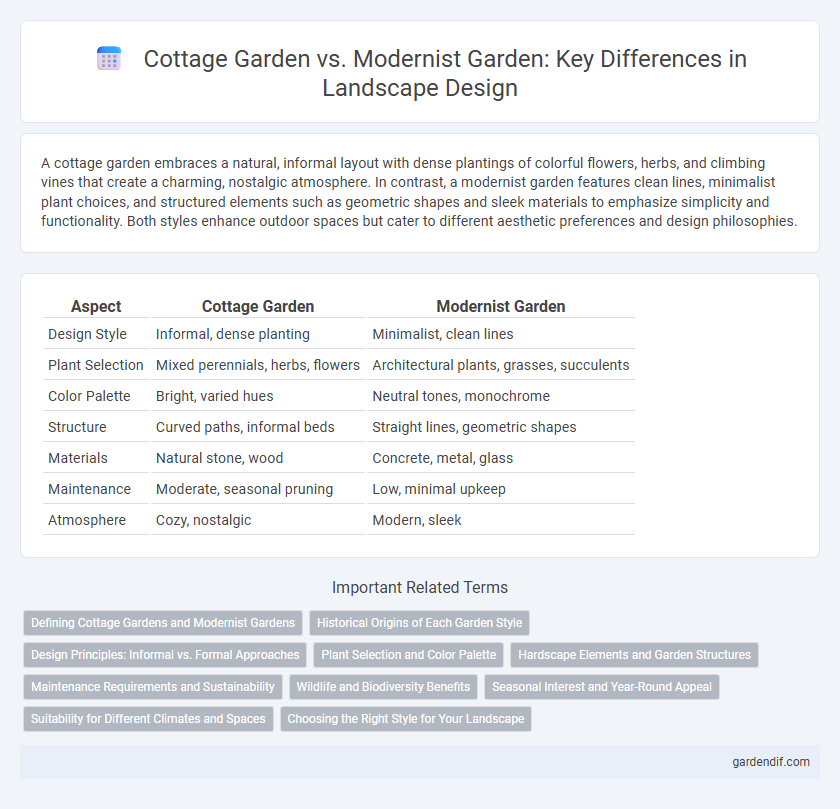
Cottage Garden vs Modernist Garden Illustration
A cottage garden embraces a natural, informal layout with dense plantings of colorful flowers, herbs, and climbing vines that create a charming, nostalgic atmosphere. In contrast, a modernist garden features clean lines, minimalist plant choices, and structured elements such as geometric shapes and sleek materials to emphasize simplicity and functionality. Both styles enhance outdoor spaces but cater to different aesthetic preferences and design philosophies.
Table of Comparison
| Aspect | Cottage Garden | Modernist Garden |
|---|---|---|
| Design Style | Informal, dense planting | Minimalist, clean lines |
| Plant Selection | Mixed perennials, herbs, flowers | Architectural plants, grasses, succulents |
| Color Palette | Bright, varied hues | Neutral tones, monochrome |
| Structure | Curved paths, informal beds | Straight lines, geometric shapes |
| Materials | Natural stone, wood | Concrete, metal, glass |
| Maintenance | Moderate, seasonal pruning | Low, minimal upkeep |
| Atmosphere | Cozy, nostalgic | Modern, sleek |
Defining Cottage Gardens and Modernist Gardens
Cottage gardens are characterized by dense, informal plantings featuring a mix of flowers, herbs, and vegetables arranged in a charming, whimsical style that emphasizes natural beauty and biodiversity. Modernist gardens prioritize clean lines, minimalism, and geometric shapes with an emphasis on structural elements like concrete, metal, and glass, often incorporating native or drought-resistant plants for sustainable design. The contrast between the two lies in the cottage garden's romantic, overflowing plant combinations and the modernist garden's sleek, organized simplicity.
Historical Origins of Each Garden Style
Cottage gardens originated in 16th-century England, rooted in traditional rural landscapes where practicality and beauty merged through dense planting of flowers, herbs, and vegetables. Modernist gardens emerged in the early 20th century, influenced by Bauhaus principles and the International Style, emphasizing minimalism, geometric forms, and a seamless integration with architectural elements. The historical evolution of cottage gardens reflects vernacular craftsmanship, while modernist gardens symbolize a break from ornamentation towards functional, clean design.
Design Principles: Informal vs. Formal Approaches
Cottage gardens embrace informal design principles characterized by dense, mixed plantings that create a natural, relaxed atmosphere using curving paths and irregular shapes. In contrast, modernist gardens prioritize formal design with clean lines, geometric patterns, and minimalistic layouts emphasizing order and simplicity. The informal approach fosters biodiversity and a sense of spontaneity, while the formal approach highlights structure and controlled aesthetics.
Plant Selection and Color Palette
Cottage gardens feature a diverse mix of perennials, herbs, and flowering shrubs with a vibrant, informal color palette emphasizing pastels and soft hues, promoting a natural and whimsical aesthetic. Modernist gardens prioritize minimalist plant selection, often incorporating structural plants like ornamental grasses and evergreens, with a restrained color palette focusing on monochromatic or bold, contrasting shades. The contrast in plant variety and color schemes reflects the cottage garden's emphasis on abundance and charm versus the modernist garden's focus on simplicity and architectural form.
Hardscape Elements and Garden Structures
Cottage gardens feature informal hardscape elements such as winding gravel paths, rustic stone walls, and wooden arbors that blend naturally with lush, dense plantings, creating a charming, whimsical appeal. In contrast, modernist gardens emphasize sleek, minimalist hardscape materials like concrete slabs, steel, and glass, often arranged in geometric patterns to complement open spaces and sculptural garden structures. Garden structures in cottage gardens include pergolas and trellises entwined with flowering vines, while modernist designs favor abstract, functional installations that enhance clean lines and spatial flow.
Maintenance Requirements and Sustainability
Cottage gardens demand frequent pruning, weeding, and seasonal planting to maintain their lush, informal aesthetic, which can increase water and resource use, impacting sustainability. Modernist gardens emphasize low-maintenance plant choices such as drought-tolerant species and hardscape elements, promoting water conservation and reduced upkeep. Sustainability in modernist gardens is enhanced by efficient irrigation systems and minimal chemical inputs, contrasting with the higher resource intensity of traditional cottage garden care.
Wildlife and Biodiversity Benefits
Cottage gardens, with diverse native plants, flowering shrubs, and layered vegetation, provide optimal habitats for pollinators, birds, and beneficial insects, significantly enhancing local wildlife diversity. Modernist gardens often emphasize minimalism and hardscaping, resulting in reduced plant variety and fewer resources for sustaining diverse species. Incorporating features like native flora, water sources, and varied vegetation in either garden style boosts overall ecosystem health and biodiversity.
Seasonal Interest and Year-Round Appeal
Cottage gardens feature diverse perennial blooms and shrubs that create vibrant seasonal interest through spring tulips, summer roses, and autumn perennials, ensuring dynamic year-round appeal. In contrast, modernist gardens emphasize structural plants like evergreens and ornamental grasses with minimalist design, offering consistent visual texture and low maintenance throughout all seasons. Strategic plant selection in both styles enhances seasonal transitions and maintains garden allure year-round.
Suitability for Different Climates and Spaces
Cottage gardens thrive in temperate climates with ample rainfall, supporting a dense mix of flowering plants and herbs that create layered textures and colors. Modernist gardens suit urban or arid environments by emphasizing minimalism and drought-tolerant species, making them ideal for small or limited spaces. Selecting between these styles depends on temperature variations, available sunlight, and soil moisture conditions to ensure plant health and design coherence.
Choosing the Right Style for Your Landscape
Cottage gardens emphasize densely planted, colorful flowers and informal layouts, creating a charming, naturalistic feel ideal for homeowners seeking a cozy, nostalgic atmosphere. Modernist gardens prioritize clean lines, minimalism, and geometric shapes, perfect for those who prefer contemporary design and low-maintenance landscapes. Selecting between cottage and modernist styles depends on personal taste, spatial constraints, and maintenance preferences to ensure harmony with your overall landscape vision.
Cottage Garden vs Modernist Garden Infographic

 gardendif.com
gardendif.com